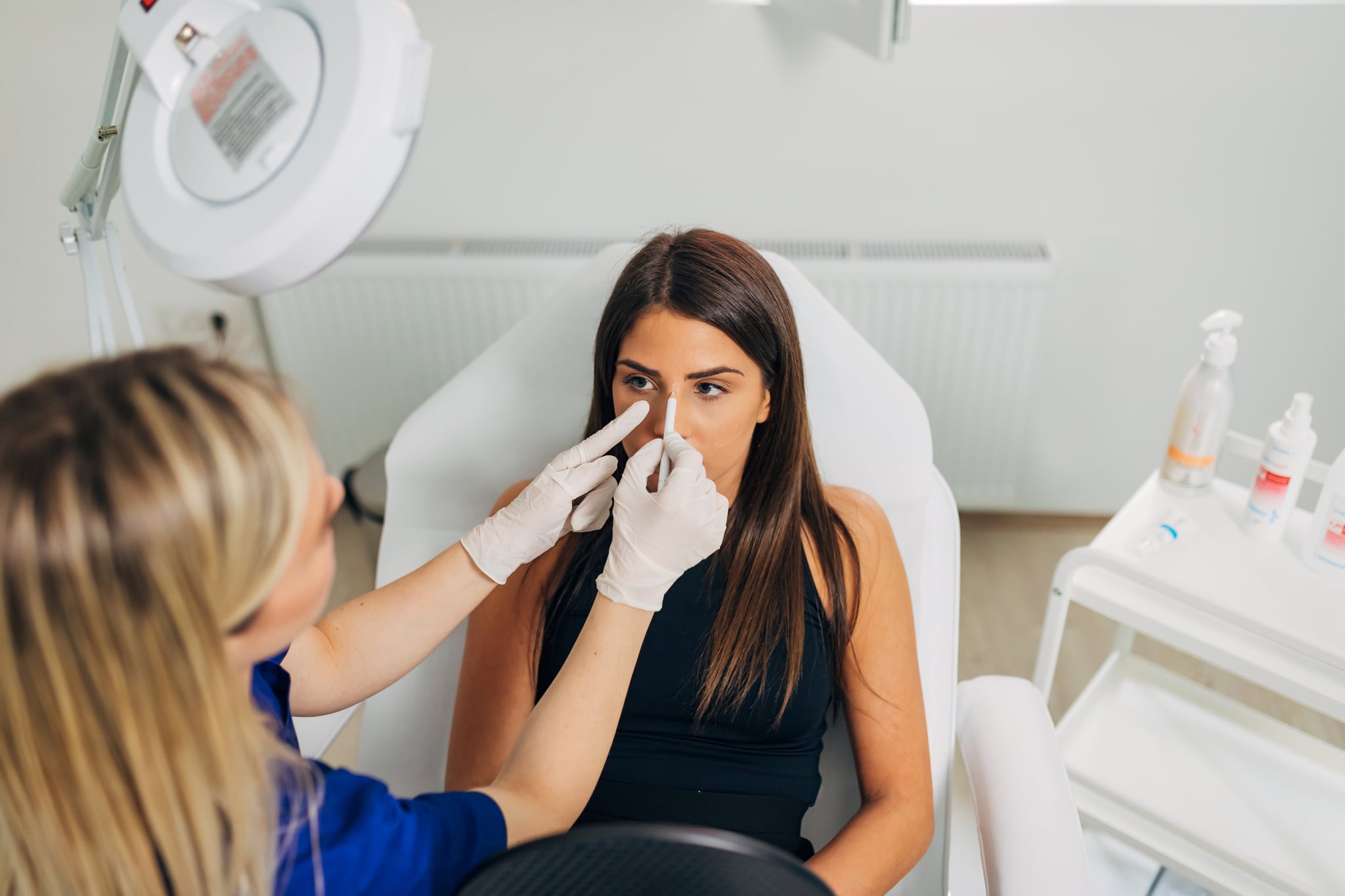Everything You Need to Know About Nose Jobs, According to a Plastic Surgeon

Image Source: Getty / Kosamtu
- Rhinoplasty is one of the most common plastic-surgery procedures.
- There are two main types of nose jobs: open rhinoplasty and closed rhinoplasty.
- Nose jobs are fairly easy outpatient procedures that typically take an hour or two.
Of all the plastic-surgery procedures out there, nose jobs are one of the most well-known. They’re talked about far more than many other treatments and frequently parodied in movies and TV. And numbers reflect this: according to the American Society of Plastic Surgery, more than 350,000 rhinoplasties were performed in 2020, making it the most common cosmetic surgical procedure. But still, not many people know what getting a nose job is like.
As with any plastic- or cosmetic-surgery procedure, people seek out nose jobs for different reasons, but generally the goal is to change the shape of their nose. “Rhinoplasty can be as dramatic or subtle as patients would like,” board-certified plastic surgeon Mark Albert, MD, MA, FACS, tells POPSUGAR. “The most common requests are to remove a hump, lift a tip, make a bulbous or boxy tip smaller, make a tip less projecting, and decrease nostril size.” There are two different types of nose-job surgeries: open and closed rhinoplasty. And if you’re looking for something nonsurgical, there’s a nonpermanent option known as a liquid nose job. Each procedure has its own benefits and may be better for some than others.
To learn more about rhinoplasty, its cost, and the risks associated with it, keep reading.
What Is Rhinoplasty, aka a Nose Job?
As we mentioned, there are two primary categories of nose jobs. “Open rhinoplasty involves an incision/scar on the underside of the nose and the skin, and soft tissue is lifted up in order to make changes to the underlying framework of the nose,” Dr. Albert explains. A closed rhinoplasty, on the other hand, doesn’t involve any external incisions: “Changes are made through the nostrils.”
The major benefit of a closed rhinoplasty is the healing process — because there are no external incisions, there’s no visible scarring. Traditionally, with closed rhinoplasty, two to three incisions are made in each nostril. However, Dr. Albert says there are ways to make it even less invasive. “I developed a variation of closed rhinoplasty using limited incisions in an effort to minimize healing, maximize predictability and safety, and to deliver the best possible results,” Dr. Albert says. His method only uses one incision per nostril.
How Old Do You Have to Be to Get a Nose Job?
People can get a nose job “as long as their bony skeleton has fully matured,” according to Dr. Albert. This usually happens around 16 for girls and 18 for boys. “Those younger than this age can be considered, but this often requires an X-ray to evaluate whether their bones have completely developed,” he says. Just keep in mind that anyone under the age of 18 will need parental consent to get this elective surgery.
Cost of a Nose Job
If you’re convinced to go for it, the next question on your mind is probably: how much does a nose job cost? Though it varies greatly depending on where you’re located and the doctor you see, the American Society of Plastic Surgery reports that the average cost of rhinoplasty is $5,483. Because nose jobs are considered elective cosmetic surgeries, they’re not likely to be covered by insurance.
Rhinoplasty Risks
As with any plastic-surgery procedure, there are risks. “The main risk after rhinoplasty is an undesirable cosmetic result,” Dr. Albert says. “This usually happens because the patient and the surgeon may not be completely on the same page before surgery as far as goals and expectations.” For this reason, it’s important to do multiple consultations leading up to surgery.
Rhinoplasty is done under local or general anesthesia, which has its own risks associated with it. Difficulty breathing postrecovery, changes in skin sensation such as numbness, and poor scarring are also possible.
What Getting a Nose Job Is Like
Rhinoplasty is an outpatient procedure that should only take an hour or two. “The procedure is usually done in an accredited office-based OR, and in some cases, an ambulatory surgery center or hospital,” Dr. Albert says. You can’t eat or drink after midnight the day before and need to arrive about 90 minutes before your surgery time to get prepped. Dr. Albert says many people don’t feel pain after the procedure and those who do only have it for a day or two, which can be controlled by pain medicine. “Most patients leave with a splint on the nose,” he adds.
Nose-Job Before and After
https://www.instagram.com/p/CpQyyTlvPYc/
Nose-Job Recovery Time
Following a rhinoplasty, patients are likely to have some bruising under the eyes for four to eight days, which can be covered with makeup. When patients are one week post-op, they’ll visit their doctor to have the splint removed from their nose. “When the splint comes off, the tip will be prominent and swollen, and the whole nose will be swollen primarily for one to two weeks,” Dr. Albert says, adding that getting the splint wet in the shower beforehand can make it easier to pull off. “After those two weeks, there is still swelling in the tissue, but it’s swelling that the general public will not notice.” If your workplace allows it, it’s recommended you work from home for at least three days after the surgery. “Most people return to work in person after seven to 10 days,” Dr. Albert adds.
Source: Read Full Article
